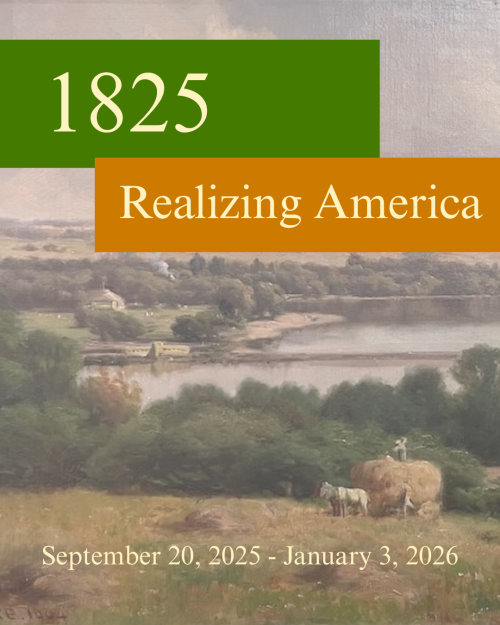
September 20, 2025 – January 3, 2026
The year 1825 saw the still young United States on the cusp of significant changes. The so called “era of good feelings” came to an end with the 1824 presidential election, the completion of the Erie Canal would bring prosperity to canal towns and help spread new ideas and movements across the country, and General Lafayette’s tour of the U.S. called into question whether the nation was living up to the ideals of the Declaration of Independence.
In Cayuga County, the population was growing and the Erie Canal would soon bring new trade options to towns along its route. Religious revivals were spreading across the state, the prevalence of agricultural industries in the county led to new inventions and advances in machinery, and new institutions were established to keep up with the changing times; the women’s prison and the Cayuga County Poorhouse were each established in 1825 as a result of social reform movements. The county, like the country, was on the threshold of change.
In this exhibit, explore life 200 years ago in Cayuga County and the many moments of this time that determined the community’s reflection of and influence on the direction of the young United States.
Stories Within this Exhibit
The year 1825 saw an emerging Cayuga County at the center of the coming expansion of New York into its status as the “Empire State.” The growing community around Auburn was one of the largest West of the Hudson, and with the completion of the Erie Canal, residents of the region stood at the cusp of transformation into an industrial center.
These are samples of some of the stories included in this exhibit. To read the full descriptions and learn more, be sure to visit this exhibit in-person!
Visit of Marquis de Lafayette
One of the most noteworthy events of the 1820s was the return visit of the Marquis de Lafayette. Lafayette had fought in the American Revolution alongside Washington and helped garner French support of the revolution. After leaving the U.S. he returned to France and pursued a political career championing the ideals of liberty that the United States represented. Inspired by the Declaration of Independence, he helped write the Declaration of the Rights of Man and of the Citizen and he was Commander in Chief of France’s National Guard during the French Revolution.
President Monroe invited Lafayette back to tour the U.S. to celebrate the nation’s 50th anniversary and to “instill the spirit of 1776” in the next generation. On August 16, 1824, Lafayette returned to the United States and spent over a year traveling to all 24 states.
Opening of the Erie Canal
The War of 1812 highlighted the need for new transportation routes that couldn’t be easily blocked by the British. This gave weight to the proposed Erie Canal, on which construction started in 1817.
New York’s oldest continuously operating canal system was completed in 1825. Construction on the Erie Canal, originally called “Clinton’s Ditch”, began on July 4, 1817 in Rome, NY. Upon its completion it spanned 363 miles from Albany to Buffalo. There are roughly twelve and a half miles of Canal running through the county, spanning from the Richmond Aqueduct in Montezuma to Lock 51 near the Onondaga County border line. The Canal ran through the towns of Montezuma, Port Byron, and Weedsport but the entire county benefited from its presence. Shipping goods was a primary use of the canal and places such as Weedsport used their connection to the canal for this purpose. A dock was built in Weedsport that was used to deliver coal that arrived by train to canal boats. An engine house was also built nearby that would allow for quicker loading times.
Life in Cayuga County
Cayuga County was quite young in 1825 having been established in 1799. Many of the towns and villages here began to form in the early 1800s which brought people to the region and shaped the county’s economic landscape. In 1825 the population of Cayuga County was 42,743 which is staggering compared to the 1,587 residents who called the county home in 1800. Auburn, being at the heart of the county, was one of the most heavily populated areas during this time, boasting a population of 2,982. During this time period Auburn was quickly becoming one of the most populated areas west of the Hudson.
An Established Black Community
Auburn has long had a Black community, even before Harriet Tubman settled here and bought her home from Frances Seward. In the earliest days of Cayuga County’s development, slavery in New York State was still legal and many of the people we think of as founding community members, such as John L. Hardenbergh and Elijah Miller, enslaved African people. A law was passed in 1817 that abolished slavery in New York State but the final date of emancipation was set for ten years later, in 1827. One of the most prominent Black families in 1825 were the Freemans. Harry and Kate Freeman were brought to the area in the late 1700s by Hardenbergh, who is often referred to as the founder of Auburn. Hardenbergh enslaved the couple and utilized their labor to build his home and gristmill on the Owasco River. Today, Harry and Kate are considered founders of Auburn.













